Don't miss any stories → Follow Tennis View
FollowNew Place, Same Faces: Rome in Review
One week after they won titles at the joint event in Madrid, Rafael Nadal and Serena Williams marched back to the title podium in Rome. Each of them stood head and shoulders above one of their key rivals in the finals, making strong statements for their candidacy at Roland Garros contenders. The Foro Italico showcased less memorable play from several other notable stars, however, while a handful of less familiar names surged to breakthroughs.
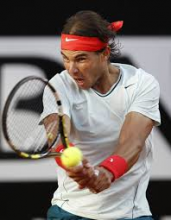 Rafael Nadal: Still the greatest show on dirt, Rafa navigated through some dangerous early matches and cruised over the finish line. In contrast to Madrid, where upsets left him facing unheralded challengers at the end, Rome forced Nadal to overcome three straight top-eight opponents. The ever-dangerous Ernests Gulbis caused him more trouble than anyone, as he did at Indian Wells, and David Ferrer extended him to a third set for the second straight week. Once past those obstacles, Nadal soared above Tomas Berdych and Roger Federer, recording his most lopsided best-of-three victory ever against the latter. His six titles and 36 matches won this year both lead the ATP, a remarkable statistic considering that he started a comeback from an eight-month absence in February. The clear favorite at Roland Garros, Nadal also guaranteed himself a top-four seed that will prevent him from playing Federer or Novak Djokovic until the semifinals. Their good fortune, not his. A+
Rafael Nadal: Still the greatest show on dirt, Rafa navigated through some dangerous early matches and cruised over the finish line. In contrast to Madrid, where upsets left him facing unheralded challengers at the end, Rome forced Nadal to overcome three straight top-eight opponents. The ever-dangerous Ernests Gulbis caused him more trouble than anyone, as he did at Indian Wells, and David Ferrer extended him to a third set for the second straight week. Once past those obstacles, Nadal soared above Tomas Berdych and Roger Federer, recording his most lopsided best-of-three victory ever against the latter. His six titles and 36 matches won this year both lead the ATP, a remarkable statistic considering that he started a comeback from an eight-month absence in February. The clear favorite at Roland Garros, Nadal also guaranteed himself a top-four seed that will prevent him from playing Federer or Novak Djokovic until the semifinals. Their good fortune, not his. A+
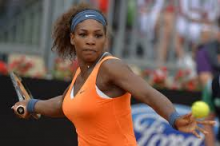 Serena Williams: Dropping just 14 games en route to the Rome title, Serena extended the longest winning streak of her career to 24 consecutive matches and four straight titles. The opponents who confronted her before the final here fell well below her level, but she never faltered in focus or discipline despite the lack of competition. Serena will need to bring those traits to Roland Garros, where she arrives as the favorite in view of her dominance over her two leading rivals there. A week after she routed Maria Sharapova in the Madrid final, she dismissed Victoria Azarenka in the Rome final with a staggering ratio of 41 winners to 19 unforced errors. Her movement on clay looked crisper than it has in many years, allowing her to stay in points longer and pick the ideal moments to end them. When Serena plays such clean, composed tennis, she becomes nearly unbeatable on any surface. A+
Serena Williams: Dropping just 14 games en route to the Rome title, Serena extended the longest winning streak of her career to 24 consecutive matches and four straight titles. The opponents who confronted her before the final here fell well below her level, but she never faltered in focus or discipline despite the lack of competition. Serena will need to bring those traits to Roland Garros, where she arrives as the favorite in view of her dominance over her two leading rivals there. A week after she routed Maria Sharapova in the Madrid final, she dismissed Victoria Azarenka in the Rome final with a staggering ratio of 41 winners to 19 unforced errors. Her movement on clay looked crisper than it has in many years, allowing her to stay in points longer and pick the ideal moments to end them. When Serena plays such clean, composed tennis, she becomes nearly unbeatable on any surface. A+
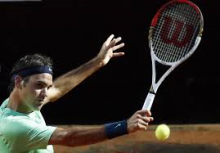 Roger Federer: He entered the tournament as the only man in the top ten who had not reached a final this year and in need of momentum after a listless early loss in Madrid. Federer succeeded in both departments, cruising to the final without dropping a set amid impressive serving and vintage net play. None of those victories came against a seeded opponent, leaving him to make these mismatches more challenging by attacking their strengths rather than their weaknesses. But Federer had suffered a series of bizarre losses over the last several years in Rome, so his first final there since 2006 should not be taken for granted. Once there, his tepid effort against Nadal showed little belief or inspiration in a sign of how much their rivalry has faded recently. A
Roger Federer: He entered the tournament as the only man in the top ten who had not reached a final this year and in need of momentum after a listless early loss in Madrid. Federer succeeded in both departments, cruising to the final without dropping a set amid impressive serving and vintage net play. None of those victories came against a seeded opponent, leaving him to make these mismatches more challenging by attacking their strengths rather than their weaknesses. But Federer had suffered a series of bizarre losses over the last several years in Rome, so his first final there since 2006 should not be taken for granted. Once there, his tepid effort against Nadal showed little belief or inspiration in a sign of how much their rivalry has faded recently. A
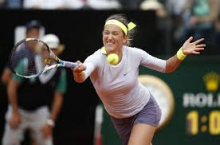 Victoria Azarenka: Like Federer, she fared much better in the second event of her return from a long absence than in the first. Gone early in Madrid, Azarenka notched victories over accomplished clay talents Samantha Stosur and Sara Errani to reach her first Rome final. She rallied repeatedly against Stosur to survive a three-set rollercoaster and similarly persevered in weathering a late-match charge from Errani. For someone who plays her least convincing tennis on clay, this result marked an encouraging reminder of her ability to contend at Roland Garros, one asterisk aside. Azarenka came no closer to challenging Serena than Sharapova did in Madrid, facing break points in every service game and playing from behind the entire match. A
Victoria Azarenka: Like Federer, she fared much better in the second event of her return from a long absence than in the first. Gone early in Madrid, Azarenka notched victories over accomplished clay talents Samantha Stosur and Sara Errani to reach her first Rome final. She rallied repeatedly against Stosur to survive a three-set rollercoaster and similarly persevered in weathering a late-match charge from Errani. For someone who plays her least convincing tennis on clay, this result marked an encouraging reminder of her ability to contend at Roland Garros, one asterisk aside. Azarenka came no closer to challenging Serena than Sharapova did in Madrid, facing break points in every service game and playing from behind the entire match. A
Surprise semifinalists: Rarely does a qualifier reach the semifinals of an event as prestigious as Rome. Simona Halep achieved that feat and achieved it the hard way, toppling former Roland Garros champion in Svetlana Kuznetsova, world No. 4 Agnieszka Radwanska, clay specialist Roberta Vinci, and former No. 1 Jelena Jankovic. Dominant in some of those matches, Halep showed surprising grit in others as she rallied from losing the first set to Radwanska and saved a match point against Jankovic. The men’s semifinals featured unseeded Frenchman Benoit Paire, who had won just six career matches at Masters 1000 tournaments before winning four this week. Paire owed more to good fortune than Halep did, defeating an ailing Juan Martin Del Potro for his only notable victory. A
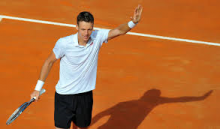 Tomas Berdych: Having lost 11 straight matches to Novak Djokovic, he must have felt that the inevitable had started to happen again when he fell behind by a set and a break in Rome. When the Serb faltered, though, Berdych mustered the confidence to pounce on the small opening and turn around the match. Multiple tests of his will unfolded late in the third set, but a man not renowned for his mental toughness found the handful of clutch serves that he needed. Berdych’s upset left him the only man other than Nadal to reach the semifinals in both Madrid and Rome, confirming him as the largest threat to the top four in Paris. A-
Tomas Berdych: Having lost 11 straight matches to Novak Djokovic, he must have felt that the inevitable had started to happen again when he fell behind by a set and a break in Rome. When the Serb faltered, though, Berdych mustered the confidence to pounce on the small opening and turn around the match. Multiple tests of his will unfolded late in the third set, but a man not renowned for his mental toughness found the handful of clutch serves that he needed. Berdych’s upset left him the only man other than Nadal to reach the semifinals in both Madrid and Rome, confirming him as the largest threat to the top four in Paris. A-
David Ferrer: To his credit, he forced long-time nemesis Nadal into a third set for the second straight week. Although Ferrer came less close to victory than he had in Madrid, he rebounded from that disappointment with more spark than he often shows against elite rivals. He also persevered after early adversity to win a three-setter against Fernando Verdasco in the previous round. Ferrer continues to struggle in winning key points, however, collecting just three of sixteen break points against Nadal. His season would look completely different (and quite remarkable) if just a few more of those key points had landed in his ledger during a handful of his key matches. B+
Samantha Stosur: While clay is arguably her best surface, Stosur lost her first match at key tournaments in Stuttgart and Madrid. Stringing together three straight victories to reach the Rome quarterfinals thus marked a major improvement, especially her first career win over Petra Kvitova. Stosur had held a match point against Kvitova earlier this year before losing, but that memory motivated rather than discouraged her. She even won a set from Azarenka, another player whom she never has defeated, before her nerves let a third-set lead slip away. B+
Ernests Gulbis: This spectacular shot-maker makes the ATP a more exciting place when he harnesses his weapons long enough to advance into draws and challenge elite opponents. Gulbis built upon his resurgence during the spring hard courts with two emphatic victories and his second three-setter of the year against Rafael Nadal. The antithesis to Rafa in playing style and personality, Gulbis came nearly as close to pulling off the upset as he did at Indian Wells. He left Rome declaring himself the most dangerous unseeded player in Paris, and, despite the characteristic hubris, it’s hard to disagree. B+
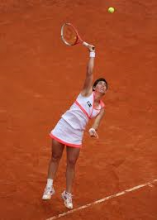 Carla Suarez Navarro: Very quietly, the small Spaniard with the flamboyant backhand has pieced together a solid clay campaign. A finalist at minor events in Acapulco and Portugal, Suarez Navarro reached the quarterfinals in Rome on the heels of an impressive comeback over world No. 11 Nadia Petrova. She extended her flawless career record in final-set tiebreaks after she saved two match points, and that first-round rally primed her for two more comfortable victories. Count her among the leading dark horses in Paris. B
Carla Suarez Navarro: Very quietly, the small Spaniard with the flamboyant backhand has pieced together a solid clay campaign. A finalist at minor events in Acapulco and Portugal, Suarez Navarro reached the quarterfinals in Rome on the heels of an impressive comeback over world No. 11 Nadia Petrova. She extended her flawless career record in final-set tiebreaks after she saved two match points, and that first-round rally primed her for two more comfortable victories. Count her among the leading dark horses in Paris. B
Sara Errani: For the second time this year, she received plenty of assistance in venturing deep into a draw. At the Paris Indoors in February, Errani played just one completed match en route to the final. Here, she became the first Italian woman to reach the Rome semifinals after playing just one completed match in addition to receiving a bye, a retirement, and a walkover. (The last of those came from Maria Sharapova, an opponent who never had lost a set to her.) Outclassed by Azarenka in the semifinals, she dropped to 0-28 in her career against top-five opponents but will rise into that group for the first time next week. If you can’t beat them, join them. B
Serbian women: Gone in the first round here after reaching the Madrid semifinals, Ana Ivanovic continued her pattern of following impressive with disappointing results. She remains a player to watch in the first week of Roland Garros, though, as does countrywoman Jelena Jankovic. A former champion in Rome, Jankovic notched her second upset over a top-10 opponent this clay season by defeating Li Na. Her quarterfinal result echoed Stosur’s week in showing form much improved from poor results at Stuttgart and Madrid. But Jankovic lost her most winnable match of the week against Halep, having won the first set. Both Serbs thus alternate between overachieving and underachieving rather than simply achieving. B-
Li Na: In contrast to Radwanska, Li has shown over the last few years that her game can adapt as well to clay as to any other surface. Quick exits from both of the marquee joint events before Roland Garros do not bode well for her title hopes there and casts some doubt over her status among the core contenders. Drawing Jankovic in the third round was not an easy assignment, though, and Li battled more fiercely throughout that match than the score showed. B-
Jo-Wilfried Tsonga: Semifinal and quarterfinal results at the two previous Masters 1000 tournaments may have raised expectations too high. Tsonga dropped his opening match at an event of this level for the first time since last August, and to an opponent (Janowicz) not known for his clay talents. Still, every week is a new week for this mercurial talent, and Tsonga’s two previous opening-round losses this year preceded strong efforts at the tournaments that followed them. C+
Novak Djokovic: The world No. 1 has sprayed consistently inconsistent results at Masters 1000 tournaments this year, losing in four different rounds and winning a title. His Rome quarterfinal loss to Berdych brought less embarrassment than early losses to Tommy Haas and Grigor Dimitrov at Miami and Madrid but came against a man whom he had dominated for years. Of particular concern was the manner of the loss, a collapse after he had led by a set and 5-2 with no apparent traces of fallibility. When the momentum started to turn, Djokovic grew distracted with imperfections in the court and stopped doing what had put him in a winning position. That’s the old, insecure Nole who once meandered in the shadows of Federer and Nadal, not the Djuggernaut of bulletproof confidence who roared past them more recently. At least his much-scrutinized ankle caused no visible issues. C+
Agnieszka Radwanska: The world No. 4 has won just one clay match this year, dropping 6-1 sets to unseeded opponents in both Madrid and Rome. While Radwanska always shines least on clay, she needs to gain positive momentum over the next few weeks before defending her Wimbledon runner-up points. A withdrawal from Brussels next week, where she would have defended the title, deepened . C-
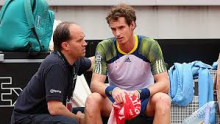 Andy Murray: The end of his pedestrian clay season might have arrived when Murray retired from his third-round match with a back injury. He sounded a gloomy note afterwards in suggesting that he might miss Roland Garros, his first absence from a major since 2007. But Murray should favor caution with Wimbledon looming so soon afterwards, maximizing his chances to recover in time for a tournament that he can win. Doctor’s note
Andy Murray: The end of his pedestrian clay season might have arrived when Murray retired from his third-round match with a back injury. He sounded a gloomy note afterwards in suggesting that he might miss Roland Garros, his first absence from a major since 2007. But Murray should favor caution with Wimbledon looming so soon afterwards, maximizing his chances to recover in time for a tournament that he can win. Doctor’s note
Maria Sharapova: Since her return from shoulder surgery, she had not played as many matches in as short a time as she would have needed to go deep in both Madrid and Rome. Sharapova looked very crisp in the two matches that she won here before withdrawing with a recurring viral illness. She will head to Roland Garros with an 11-1 clay record in 2013 and the confidence that she can defend her title unless she faces Serena. Incomplete
Juan Martin Del Potro: Ousted by Paire in the third round, the Argentine will remember that loss far less clearly than his meeting with Pope Francis on Wednesday. Del Potro found the experience of meeting the first pontiff from his nation so moving that he gave him a valuable prize: the racket that he used on championship point at the 2009 US Open. That moment made his trip to Rome worthwhile despite the worsening bronchial infection that forced Del Potro home to Argentina afterward. Doctor’s note
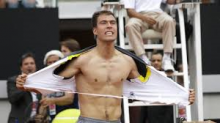 Jerzy Janowicz: The Polish rising star broke the hearts of French fans by upsetting first Jo-Wilfried Tsonga and then Richard Gasquet. Those consecutive victories over top-ten opponents illustrated Janowicz’s ability to translate his fast-court game to the clay. Booming serve-forehand combinations and delicate drop shots nearly carried him into a final set against Federer in the quarterfinals. Still a raw competitor who struggles to contain his emotions, Janowicz must learn how to handle minor adversity better. Shot for shot, he showed that he can stand toe to toe with anybody. Skip a grade
Jerzy Janowicz: The Polish rising star broke the hearts of French fans by upsetting first Jo-Wilfried Tsonga and then Richard Gasquet. Those consecutive victories over top-ten opponents illustrated Janowicz’s ability to translate his fast-court game to the clay. Booming serve-forehand combinations and delicate drop shots nearly carried him into a final set against Federer in the quarterfinals. Still a raw competitor who struggles to contain his emotions, Janowicz must learn how to handle minor adversity better. Shot for shot, he showed that he can stand toe to toe with anybody. Skip a grade
Andreas Seppi: Defending quarterfinal points from Rome last year, he folded meekly in the first round to compatriot Fabio Fognini. Seppi’s early exit from his home Masters 1000 tournament continues his trend of regression in 2013 from what looks likely to remain his career year in 2012. Lost his homework
Viktor Troicki: Umpiring did not shine this week, from a clearly botched call that cost Gasquet a break against Janowicz to another obvious error that handed Gulbis a break against Troicki. Gasquet accepted the incorrect call after making his case to the umpire and acknowledged with grace that he could have won the match anyway. By contrast, grace did not describe the childish tantrum by Troicki that ended up on ESPN’s SportsCenter and other forums not normally devoted to tennis. Even Gulbis, hardly a model of decorum, thought that Troicki exceeded proper sportsmanship when he delayed play between games for nearly five minutes. He even dragged a cameraman out to the baseline to film the offending ball mark. Troicki’s shot may have fallen on the line, but his conduct fell well beyond it. Detention










